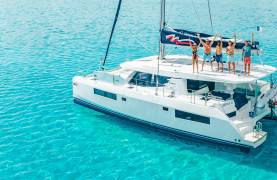
Catamarans have many advantages over monohulls when it comes to sitting at anchor or on a mooring. In particular, their shallower draft means that you can get closer to shore and often in less crowded areas. Keep in mind, however, that anchoring a catamaran can be tricky if you’re used to maneuvering monohulls, which don’t have as much windage. Slow and steady anchoring as well as proper preparations are the keys to catamaran technique success.
Before dropping anchor, of course, be sure to cruise around the area to check for depth variation, sandy vs. grassy spots, and take note of how other boats nearby have safely and effectively secured their locations. And unless you are a skilled and seasoned sailor, you should be anchoring under power with tight sails at all times.
Catamarans pair perfectly with beaches because they allow you to get in closer to anchor. The two engines are a great benefit for maneuvering in general and moving backward easily, which is very useful when anchoring as it allows the catamaran to “dig” the anchor deeper once set in place. Be aware that with catamarans, the anchor windlass roller is set back further on the deck. Because of this a bridle should be used, which reduces the load on the anchor chain, reduces wear on the boat, and acts as a shock absorber.
If you need visual support, our video below filmed from a Catamaran in the BVI will certainly help you to understand the technicity of this move.
Contributor
Leslie Montenegro
Step Aboard Here
Start your experience with The Moorings on land and sign up to receive e-mails from us about yachts, offers and destinations.
By clicking 'Sign up' you confirm that you have read and understood our Privacy Policy and consent to our use of your information.



